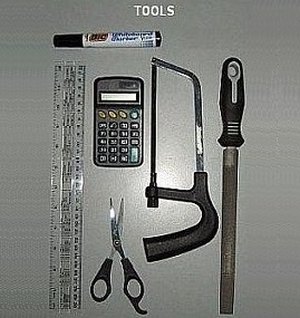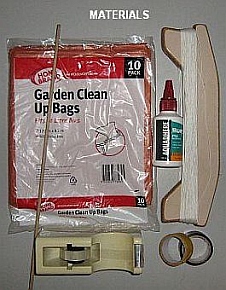- Home Page
- Accessories
- Kite Making Tools
Kite Making Tools and Materials
For the MBK Dowel Kites
This page details absolutely all the kite making tools and materials needed except for child-size shoelaces that are used as spar ties.
The "tools" and materials described below aren't quite as minimal as needed for the skewer kites—but heck, it's a pretty close second!
On this site, there's more kite-making info than you can poke a stick at. :-)
Want to know the most convenient way of using it all?
The Big MBK E-book Bundle is a collection of downloads—printable PDF files which provide step-by-step instructions for many kites large and small.
Every kite in every MBK series.
Tools
A black permanent marker. These pens are for drawing corner points and sail outlines on light-colored plastic. They are also handy for marking dowel before cutting it to length or marking where bridle legs are to be attached.

A ruler. Any length or type will do. All MBK kites use straight lines to make things easier and quicker. What if the ruler is too short for a long sail edge? It's simple to stretch out a length of flying line, weighted at each end, to mark several intermediate dots. These dots can then be connected using the small ruler. Voila! A long straight line.
A pair of scissors. This simple kite-making tool is
mainly for cutting around the outline of the sail. It's also handy for
cutting flying line to length for constructing bridles, trimming excess
line, and snipping off lengths of electrical tape.
A small cheap hacksaw. Use this for cutting wooden dowel to length.
A cheap medium-grade wood file. Use this for rounding spar ends and cutting notches for securing bow lines. Not everyone has kite-making tools like saws and files just lying around the house, but these are very widely available in shops.
A calculator. Yes, find a calculator of some sort, like on your cell phone (mobile) or the Windows one or whatever. But there's no heavy calculating to be done; it's just handy for those using Dowel Length units to create a kite on a different scale to my originals.
A smooth flat area to work on. It only needs to be 2 meters (7 feet) square or so. Even if you are living in a tiny apartment, it's possible to use these kite-making tools to get something impressive in the air!
Materials
Flying line, of 50-pound strength or more. Use this for bridles and other lines attached to the frame. I'm using 50-pound braided Dacron for flying line and bridling. This has ample strength for flying the MBK Dowel Series kites in light-to-moderate winds.
If you want something slightly cheaper, you might use nylon line instead. Another option, if you can get it cheap enough, would be the heaviest grades of polyester thread.
Electrical insulation tape, available from hardware stores. This stuff stretches and therefore is perfect for capping spar ends while attaching sail plastic at the same time. Although a bit heavy, only small lengths are required, so it doesn't add much weight overall.

Lightweight, clear sticking tape. That is, Scotch tape, Sello-tape tape, or whatever you like to call it. Just make sure it is about
the width of your finger. The tape I use is 12 millimeters (1/2 inch) in width.
This is used to reinforce the edge of the sail, since it doesn't stretch and doesn't add much weight.
Large translucent (see-through) colored plastic bags for making sails. Here in Australia, large orange garden bags are available from supermarkets. These bags are ideal and also make the finished kite easy to see in the air! Use the lightest single-ply bags you can find for these light-wind kites. Color-wise, you must be able to see a black marker pen line through the plastic. The MBK construction method relies on this. Heavier plastic will sacrifice a little light-wind performance in return for a more durable kite. It's your choice!
Wood dowels. The one pictured is 5 millimeters (3/16 inch) in diameter, which
needs to be cut to length for the dowel kites. MBK Dowel designs use
just a few dollars worth of dowel for each kite. After making and
testing the sled, diamond, and barn door, I figured out that the ideal
dowel was 5 millimeter hardwood such as the Tasmanian oak available here. Elsewhere, red oak should be OK.
In North America, Chinese poplar is commonly available as dowel. This is softer than oak and other hardwoods, so 1/4-inch diameter would be a more appropriate size.
Wood glue, such as the Aquadhere in the photo. For most of the dowel kites, this is only used for securing knots. Hence only very small amounts are needed, and it dries much quicker than expected. Even the other uses, such as box-kite cross pieces, need relatively small amounts. A 100 ml container will last a long time when just used for making MBK kites. If you are in a hurry, you will need to spend considerably more per 100 ml on a tube of fast-setting general-purpose glue.
Shoelaces are used for securing spars to each other. We found that cheap polyester laces designed for a child's shoes were ideal, since they were adequately strong yet not too bulky or heavy.
As long as you have access to supermarkets and hardware stores you should be able to get these kite-making tools and materials together! Many of the items are probably lying around your house somewhere already.
As mentioned earlier, there's more kite making on this site than you can poke a stick at. :-)
Want to know the most convenient way of using it all?
The Big MBK E-book Bundle is a collection of downloads—printable PDF files that provide step-by-step instructions for many kites large and small.
That's every kite in every MBK series.
